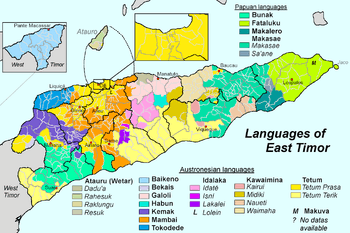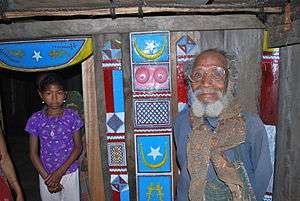Bunak people
|
Holy House in Fatuc Laran, Lactos, Cova Lima District, East Timor where 90% of the population are Bunak people. | |
| Total population | |
|---|---|
| (84,000[1]) | |
| Regions with significant populations | |
|
Timor Island: East Timor (61,000)[2] West Timor, Indonesia (23,000)[3] | |
| Languages | |
| Bunak language | |
| Religion | |
| Animism (originally), Catholic (predominantly) | |
| Related ethnic groups | |
| Papuan people |
The Bunak (also known as Bunaq, Buna', Bunake) are an ethnic group that live in the mountainous region of central Timor, split between the political boundary between West Timor, Indonesia, particularly in Lamaknen District and East Timor. Their language, Bunak language, is one of the few on Timor which is not an Austronesian language, but rather a Papuan language like groups on New Guinea. It is usually put in the proposed language group Trans–New Guinea.[4] They are surrounded by groups which speak Malayo-Polynesian languages, like the Atoni and the Tetum.
According to Languages of the World (Voegelin and Voegelin, 1977), there were about 100,000 speakers of the language, split evenly between the two nations.
Settlement area
Today's settlement area of the Bunak people are located in the mountains of central Timor, ranging from the East Timorese town of Maliana in the north to the Timor Sea in the south, where both the Bunak and the Tetun Dili communities often live side by side in coexistence.[5] The Bunak people are isolated linguistically and socially, since the adjacent Kemak people are in the north, the Mambai people in the east, Tetun Dili people in the south and west and the rest of the Atoni people speak Malayo-Polynesian languages in the west. While Bunak are considered as one of the Papuan languages, even though there are strong influences of neighboring languages. Papuan languages are usually spoken only in the far east of Timor. Because of the language diversity in the region, the Bunak people are able to dominate at least one of the Malayo-Polynesian languages fluently (in East Timor, Tetum language is the lingua franca), while their surrounding neighbors rarely learn Bunak language.[6] In the hard reach mountains, the settlements of the Bunak people are relatively isolated from their neighboring communities. In East Timor, their settlement area expands to the west of Manufahi District and in the West Timor of Indonesia towards the east of the Belu Regency and Malaka Regency.[5]
The Bunak people of East Timor centers in places like Bobonaro and Lolotoe in the town of Bobonaro District, Tilomar Subdistrict and Zumalai in the municipality of Cova Lima District, Cassa in the municipality of Ainaro District, and Betano and Same in the municipality of Manufahi District. In the western border area of Cova Lima District, the Bunak people form a minority against the majority population of Tetun Dili people. However, the settlements are mixed. Between Fohoren and the coast south of Suai the villages of the Tetun Dili people and Bunak people are found interwoven.[7] A total of 55,837 East Timorese consider Bunak language as their native language.[8]
To the eastern region of the West Timor of Indonesia, the Bunak people in Belu Regency form the majority in Lamaknen and South Lamaknen districts, and as a minority in Riahat district in the southeast.[9] Similarly, in the southeast of West Timor, the Tetun Dili people form the majority. Individual Bunak settlements can be found among Tetun Dili villages in the Rai Manuk district of Belu Regency, Kobalima, East Kobalima and East Malaka district of Malaka Regency. The westernmost of Bunak settlements are Haroeh (Sanleo Administrative village, East Malaka district) and Welaus (North Lakekun Administrative village, Kobalima district). In the northwest are the isolated Bunak villages of Faturika, Renrua (both in Rai Manuk district) and Babulu (Kobalima district). To the east the settlements of Bunak people lie along the road to the Alas and South Alas Administrative village of East Kobalima district at the border with East Timor.[7]



Notes
Bibliography
- Claudine Friedberg (1989), Social relations of territorial management in light of Bunaq farming rituals, Journal of the Humanities and Social Sciences of Southeast Asia, ISSN 0006-2294
- Geoffrey C. Gunn (1989), History of Timor (PDF), ISEG Lisbon School of Economics & Management
- Antoinette Schapper (2011), Crossing the border: Historical and linguistic divides among the Bunaq in central Timor, The Journal of Indonesian Humanities
- Antoinette Schapper (2011), Andrew McWilliam & Elizabeth G. Traube, ed., Land and Life in Timor-Leste, ANU E Press, ISBN 9781921862595
References
- ↑ "Bunak people". Joshua Project. Retrieved 2014-09-16.
- ↑ "Bunak people in East Timor". Joshua Project. Retrieved 2014-09-16.
- ↑ "Bunak people in Indonesia". Joshua Project. Retrieved 2014-09-16.
- ↑ Antoinette Schapper. "What is it to be Papuan? Bunak: a non-Austronesian language of Eastern Indonesia". Research Gate. Retrieved 2015-01-19.
- 1 2 Antoinette Schapper. Land and Life in Timor-Leste. p. 164.
- ↑ Antoinette Schapper. Land and Life in Timor-Leste. p. 163.
- 1 2 Antoinette Schapper. Land and Life in Timor-Leste. p. 175.
- ↑ "Population and Housing Census 2010: Population Distribution by Administrative Areas Volume 2" (PDF). National Statistics Directorate & United Nations Population Fund. 2011. Retrieved 2016-11-14.
- ↑ Antoinette Schapper. Land and Life in Timor-Leste. p. 165.
- ↑ "Download Suco Reports". Timor-Leste Ministry of Finance. Retrieved 2016-11-14.
Further reading
- Louis Berthe, 1972 Bei Gua: Itinéraire des ancêtres, Paris.
- Claudine Friedberg, Boiled Woman and Broiled Man: Myths and Agricultural Rituals of the Bunaq of Central Timor, in James J. Fox (Editor) 1980, The Flow of Life. Essays on Eastern Indonesia, Harvard University Press.
- Claudine Friedberg (1977), La femme et le féminin chez les Bunaq du centre de Timor, Archipel
